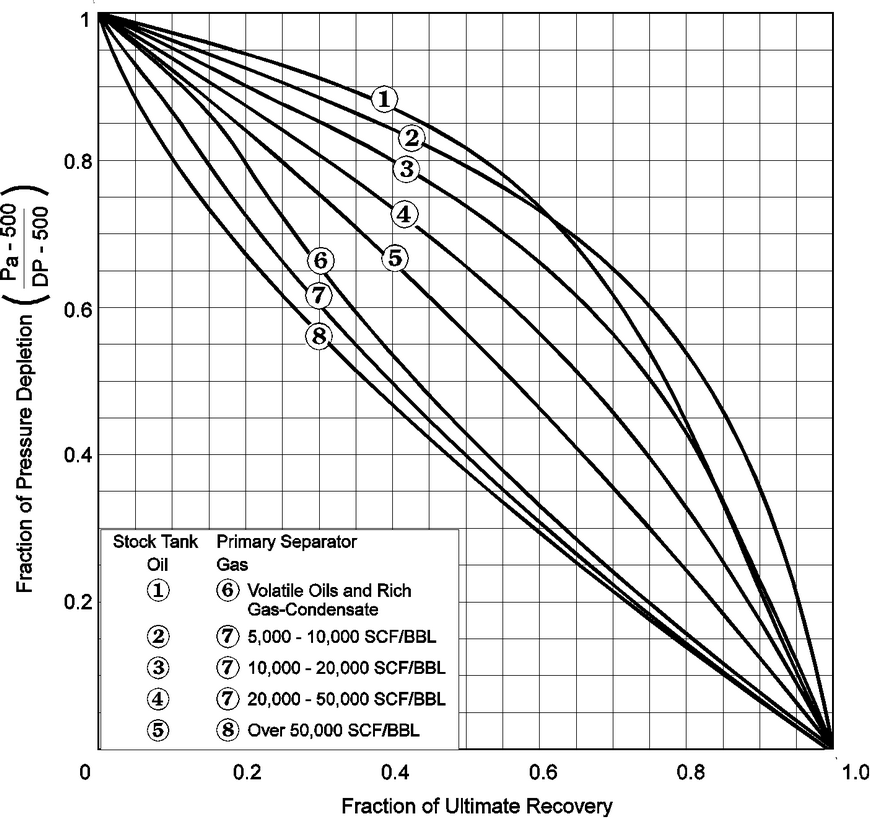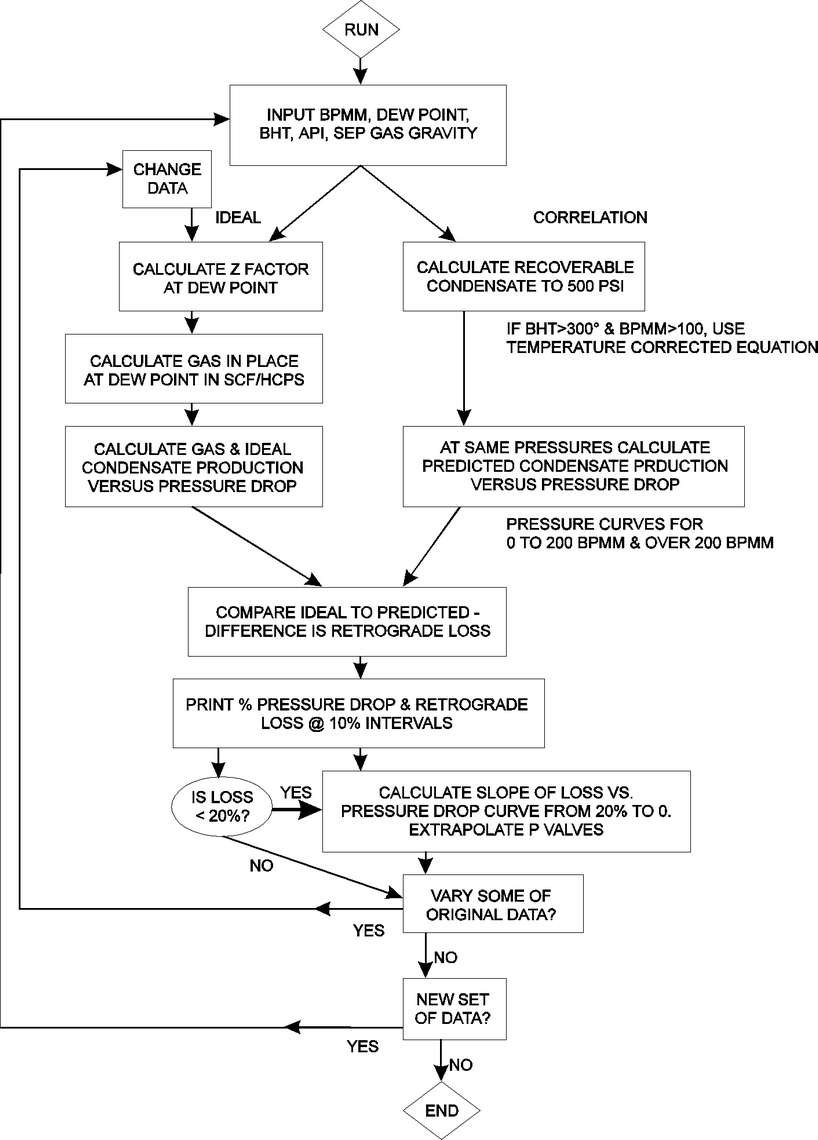Gas Volumetrics |
|
To use the Advanced Volumetrics Module, enter in the relevant numbers for the reservoir. Petra creates a report on the right side of the screen. This report screen is automatically updated to reflect the most recent volumetric parameters entered. While some entries are necessary for the calculation (like TVD), other values are optional and exist only to override values Petra calculates automatically (such as the Z Factor). An * next to the entry name signifies mandatory entries. Once all the entries are set, Petra automatically performs the reservoir calculation and displays a report on the right side of the screen. 1 - Reservoir InfoThough its optional, the first step is to enter the name of company, the field, the reservoir, and the county. These entries show up on the top of all reports. 2 - Reservoir PropertiesDrive Mechanism* -This dropdown menu governs how Petra treats reservoir depletion due to production. Volumetric Use this method for reservoirs that are driven by volumetric expansion of gas after a drop from initial reservoir pressures. The effects of water and formation compressibility are also included in this method. Water Drive (100 Percent Pressure Maintenance) Use this method when all gas recovery is due to water sweeping the entire drainage area. Importantly, this method assumes no pressure loss with production. Initial and abandonment pressures are assumed to be equal. Partial Water Drive Use this method with a mixed system of volumetric and water drives. This method assumes two-part depletion: a volumetric depletion to abandonment pressure and then an additional recovery in the water-swept zone. Average TVD of Reservoir* - Enter the average true vertical depth of the horizon. Petra accepts values between 300 and 35,000. Formation Pressure Gradient* - Enter the formation pressure gradient. Petra accepts values between 0.05 and psi/ft. Average Porosity* - Enter the volume-weighted average porosity of the producing formation in percent. Petra accepts values between 0.01 and 100 percent. Remember to use whole numbers instead of decimal percentages. Formation Compressibility* Enter the average compressibility of the formation. Petra accepts values between 0.01 and 200 1/psi(E-6). Connate Water Saturation* - Enter the connate water saturation of the producing horizon in percent. Petra accepts values between 1 and 99.99 percent. Remember to use whole numbers instead of decimal percentages. Residual Gas Saturation - Enter the residual gas saturation to override the internally-calculated value. By default, Petra calculates the residual gas saturation with the Legatski-Katz correlation for clean sands. This entry is only used for 100% Water Drive and Partial Water Drive reservoirs. Remember to use whole numbers instead of decimal percentages.
where: Sr = Residual gas saturation, percent φ = Porosity, percent
Initial Pressure* - Enter average reservoir pressure at final conditions. Petra accepts values between 14 and 20,000 psia. Abandonment Pressure* - Enter average reservoir pressure at final conditions. Petra accepts values between 14.7 and 500 psia. This entry is not used for water drive reservoirs because abandonment reservoir pressure equals the initial reservoir pressure. Reservoir Temperature* - Enter the temperature of the producing horizon. Petra accepts values between 40 and 500 degrees. Vertical Conformance Factor - Enter the vertical conformance factor, which is a measure of the uniformity of vertical permeability. It is usually calculated as volumetric sweep efficiency divided by the areal pattern efficiency, and is assumed to equal the fraction of waterswept portion of the reservoir actually contacted by water. In a sense, it is a measure of water-drive efficiency. Net Interest* - Enter the company's working interest before royalty. Petra accepts values between .01 and 100 percent. Remember to use whole numbers instead of decimal percentages. 3 Gas Reservoir VolumesTotal Reservoir Volume* Enter the size of the reservoir in acre-feet. Petra accepts values between 0.01 and 1xE13 acre-feet. Water Invaded Volume* - Enter the size of the water-invaded part of the reservoir in acre-feet. Petra accepts values between 0.01 and 1xE9 acre-feet. 4 - Gas Fluid PropertiesType of Gas Gravity* This dropdown governs how Petra handles gas gravity. Wellstream Gas Gravity This option indicates the gas gravity was measured at the wellstream. Separator Gas Gravity This option indicates the gas gravity was measured at the separator. Gas Gravity* - Enter specific gravity of the solution gas relative to air. Petra accepts values between 0.55 and 10. Condensate Loss Method* - In the absence of PVT information, this option helps to account for the effect of retrograde condensate on ultimate recovery. Eaton-Jacoby The Eaton-Jacoby uses a series of curves to estimate the percentage of production lost to retrograde condensate. It is limited to reservoirs between 4,000-12,000 psi, 160-290 f, 2,500 to 60,000 scf/STBO, and 5-65 oil gravities.
Modified Eaton-Jacoby The original Eaton-Jacoby method was modified by Amoco to better suit reservoirs in the Gulf of Mexico.
Condensate Yield Enter the ratio of condensate produced per MMSCF. Petra accepts values between 1 and 200. Setting this yield to zero sets the fractional retrograde loss to zero. Condensate Gravity - Enter the condensate gravity. Petra accepts values between 1 and 200. Condensate Gas Equivalent - Enter the condensate gas equivalent. .Petra accepts values between 0 and 1000000. Fuel Factor* - Enter the percent of the separator gas used to power process equipment. Petra accepts values between .01 and 100 percent. Remember to use whole numbers instead of decimal percentages. Nitrogen - Enter the mole percent of nitrogen in the produced gas. Petra accepts values between 0 and 90 percent. Remember to use whole numbers instead of decimal percentages. Carbon Dioxide - Enter the mole percent of carbon dioxide in the produced gas. Petra accepts values between 0 and 90 percent. Remember to use whole numbers instead of decimal percentages. Hydrogen Sulfide - Enter the mole percent of hydrogen sulfide in the produced gas. Petra accepts values between 0 and 90 percent. Remember to use whole numbers instead of decimal percentages. 5 - Gas Cumulative ProductionGas at Separator* - Enter the total amount of separator gas produced from the discovery date to the date of reserve determination. Make sure to include gas used as fuel. Condensate* - Enter the total condensate from the discovery date to the date of reserve. |


